Ask a question from expert
BSBCNV501 - Take instructions in relation to a transaction
71 Pages36889 Words146 Views
Take instructions in relation to a transaction (BSBCNV501)
Added on 2022-01-21
BSBCNV501 - Take instructions in relation to a transaction
Take instructions in relation to a transaction (BSBCNV501)
Added on 2022-01-21
BookmarkShareRelated Documents
NBIA V2:816 BSBCNV501 Take Instructions NBIA- The Specialists in Learning and Development 1
BSBCNV501 Take instructions in relation to a transaction
Student Workbook
melbourne . sydney . brisbane . adelaide . tasmania
Phone: (03) 9584 0900
www.nbi.com.au
RTO # 21476
National Business
Institute of
Australia
2/27 Grange Road. Cheltenham Vic 3192 www.nbi.com.au (03) 9584 0900
BSBCNV501 Take instructions in relation to a transaction
Student Workbook
melbourne . sydney . brisbane . adelaide . tasmania
Phone: (03) 9584 0900
www.nbi.com.au
RTO # 21476
National Business
Institute of
Australia
2/27 Grange Road. Cheltenham Vic 3192 www.nbi.com.au (03) 9584 0900
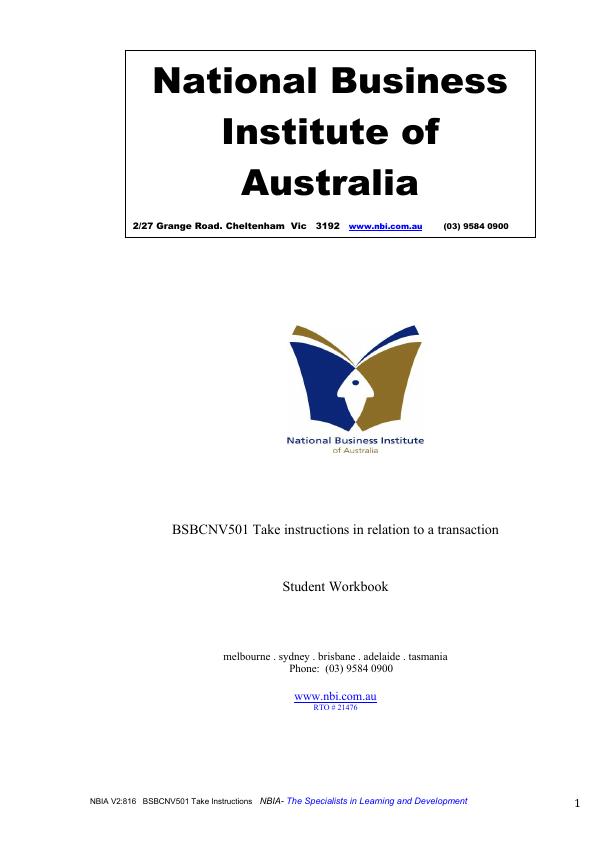
NBIA V2:816 BSBCNV501 Take Instructions NBIA- The Specialists in Learning and Development 2
BSBCNV501 Take instructions in relation to a transaction
This unit describes the skills and knowledge required to take instructions from a potential client in order
to initiate a real estate, business or personal conveyancing transaction.
It applies to individuals who communicate with clients to establish the client’s needs, and identify
conflicts of interest, parties, properties and other interests, and determine terms of engagement and
contingency strategies. Work functions in the occupational areas where this unit may be used are subject
to regulatory requirements.
Assessment Requirements:
This unit may be assessed in the workplace or in a simulated environment. To be deemed competent for
this unit, you need to successfully complete all assessment criteria and submit all q+a in the workbook,
any research required, answer tutorial questions successfully, be involved and proactive in any role plays,
and have all the elements and competencies in the unit that require observation be completed by your
peers or the assessor. After taking all of these aspects into consideration and receiving evidence you have
met the ‘evidence guide’ requirements stated above, the assessor will judge as to whether you are to be
deemed competent or not yet competent. If you are deemed NYC, you may be given additional work or
time, to complete the required criteria.
The signed and completed assessment sheet listing the elements and competencies (at the end of this
workbook) will be evidence this has occurred. People with disabilities may use assistive technologies to
demonstrate interview skills and /or receive and respond to oral and or written questioning.
Each unit workbook has formative and summative questions and assignments that must be completed
satisfactorily and submitted for the candidate to be assessed as competent.
All workbook questions and answers must be completed and returned in hard copy to NBIA as one unit
in a legible and acceptable form, preferably typed-Times New Roman font size 12, all q+a written and
numbered, with correct punctuation, spelling, not bound or stapled and of a standard reflective of the
level of the qualification being studied.
Questions throughout the workbook will be designated with a ‘W’ and then a numeral eg w1,w2 etc, and
the final assessment questions by numeral only. Please take the time to re read the “Important Instructions”
sent in your course commencement email.
Reference texts include:
It is not a requirement to purchase the following texts, but as in all study, the use and ownership of
reference texts are very helpful and can broaden your knowledge.
Australian Business Law Latimer : CCH
Astor H & Chinkin C, Dispute Resolution in Australia, LexisNexis Butterworths, Sydney, 2002.
Carter, J, Peden, E, Tolhurst, G, Contract Law in Australia, 7th ed, Lexis Nexis Butterworths, Sydney, 2007
CCH Victorian Conveyancing Law and Practice Volume
Conveyancing Manual NSW Looseleaf Service published by Thomson Reuters Law Book Co.
Conveyancing Victoria: Simon Libbis : Hybrid Publishers
Conveyance Works, All You Need to Know About Conveyancing in Vic: S. Libbis & R.Cocks.
De Groot, John K & Maxwell, Kay F, Legal Letter Writing, Blackstone Press Pty Ltd, Sydney, 1994.
Fisher R & Ury W, Getting to Yes: Negotiating Agreement Without Giving in, Business Books, 1989
Fundamentals of Business Law ML Barron McGraw Hill
Lang, Andrew, Conveyancing Precedents, Australia and New Zealand, CCH Australia Limited,1988
Neave, M A, Rossiter, C J & Stone, M A, Sackville and Neave, Property Law, Cases and Materials, 6th ed,
Butterworths, Sydney, 1998.
New South Wales Conveyancing Law and Practice Looseleaf Service published by CCH.
NSW Estate Agency Law and Practice by Pamela Morgan 6th ed. published by Thomson Reuters.
Step by Step Guide to operating a successful Conveyancing Practice, G Brown 1300 275 272
Voumard – Sale of Land
The 1958 Property Law Act
Ronan, Conveyancing Law and Practice (Lawbook Co, 2017)
The student must own/have possession of /have available current state versions of:
Conveyancing Law and current Legislations eg Conveyancing Licencing Acts
BSBCNV501 Take instructions in relation to a transaction
This unit describes the skills and knowledge required to take instructions from a potential client in order
to initiate a real estate, business or personal conveyancing transaction.
It applies to individuals who communicate with clients to establish the client’s needs, and identify
conflicts of interest, parties, properties and other interests, and determine terms of engagement and
contingency strategies. Work functions in the occupational areas where this unit may be used are subject
to regulatory requirements.
Assessment Requirements:
This unit may be assessed in the workplace or in a simulated environment. To be deemed competent for
this unit, you need to successfully complete all assessment criteria and submit all q+a in the workbook,
any research required, answer tutorial questions successfully, be involved and proactive in any role plays,
and have all the elements and competencies in the unit that require observation be completed by your
peers or the assessor. After taking all of these aspects into consideration and receiving evidence you have
met the ‘evidence guide’ requirements stated above, the assessor will judge as to whether you are to be
deemed competent or not yet competent. If you are deemed NYC, you may be given additional work or
time, to complete the required criteria.
The signed and completed assessment sheet listing the elements and competencies (at the end of this
workbook) will be evidence this has occurred. People with disabilities may use assistive technologies to
demonstrate interview skills and /or receive and respond to oral and or written questioning.
Each unit workbook has formative and summative questions and assignments that must be completed
satisfactorily and submitted for the candidate to be assessed as competent.
All workbook questions and answers must be completed and returned in hard copy to NBIA as one unit
in a legible and acceptable form, preferably typed-Times New Roman font size 12, all q+a written and
numbered, with correct punctuation, spelling, not bound or stapled and of a standard reflective of the
level of the qualification being studied.
Questions throughout the workbook will be designated with a ‘W’ and then a numeral eg w1,w2 etc, and
the final assessment questions by numeral only. Please take the time to re read the “Important Instructions”
sent in your course commencement email.
Reference texts include:
It is not a requirement to purchase the following texts, but as in all study, the use and ownership of
reference texts are very helpful and can broaden your knowledge.
Australian Business Law Latimer : CCH
Astor H & Chinkin C, Dispute Resolution in Australia, LexisNexis Butterworths, Sydney, 2002.
Carter, J, Peden, E, Tolhurst, G, Contract Law in Australia, 7th ed, Lexis Nexis Butterworths, Sydney, 2007
CCH Victorian Conveyancing Law and Practice Volume
Conveyancing Manual NSW Looseleaf Service published by Thomson Reuters Law Book Co.
Conveyancing Victoria: Simon Libbis : Hybrid Publishers
Conveyance Works, All You Need to Know About Conveyancing in Vic: S. Libbis & R.Cocks.
De Groot, John K & Maxwell, Kay F, Legal Letter Writing, Blackstone Press Pty Ltd, Sydney, 1994.
Fisher R & Ury W, Getting to Yes: Negotiating Agreement Without Giving in, Business Books, 1989
Fundamentals of Business Law ML Barron McGraw Hill
Lang, Andrew, Conveyancing Precedents, Australia and New Zealand, CCH Australia Limited,1988
Neave, M A, Rossiter, C J & Stone, M A, Sackville and Neave, Property Law, Cases and Materials, 6th ed,
Butterworths, Sydney, 1998.
New South Wales Conveyancing Law and Practice Looseleaf Service published by CCH.
NSW Estate Agency Law and Practice by Pamela Morgan 6th ed. published by Thomson Reuters.
Step by Step Guide to operating a successful Conveyancing Practice, G Brown 1300 275 272
Voumard – Sale of Land
The 1958 Property Law Act
Ronan, Conveyancing Law and Practice (Lawbook Co, 2017)
The student must own/have possession of /have available current state versions of:
Conveyancing Law and current Legislations eg Conveyancing Licencing Acts
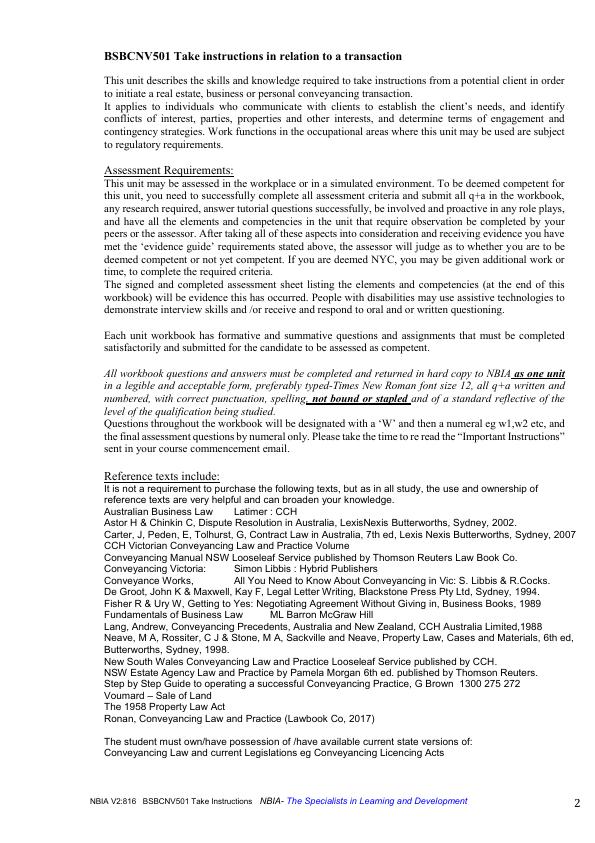
NBIA V2:816 BSBCNV501 Take Instructions NBIA- The Specialists in Learning and Development 3
Conveyancing Codes of conduct
Estate property laws eg Retail Leases Act,
Tenancies acts eg Retail tenancies Act
Sale of land acts
Also go to Consumer Affairs Vic website, and source the “Guide for Conveyancers” as a reference
Download and read fully:
The current Sale of Land Act and Transfer of Land Act e.g. http://www.legislation.vic.gov.au/
http://www.austlii.edu.au/
http://www.legislation.nsw.gov.au
AIC : sample contract of sale and rules of professional conduct
Your state government consumer advice centre or equivalent re Rental premises e.g. Consumer Affairs in
Victoria e.g. consumer.vic.gov.au
The Law Institute sample of Pre Contract and post Contract checklists for Conveyancers/property
settlements and risk/file notes from Legal Practitioners Liability Committee e.g.
https://lplc.com.au/wp-content/uploads/2015/07/Useable-trail-–-fail-to-record-advice-at-your-own-peril-
Transcript-00092576.pdf
A sample Certificate of Title from your State Government e.g. your home or your parents home etc.
Estate Agents Act
Conveyancing Act relevant to your state
Also
Accc.gov.au
Austlii.edu.au
Landata.vic.gov.au
www.Lpcl.com.au/manage-avoid-conflict/
LPLC – ‘claim free conveyancing’
Your State Revenue office eg https://www.sro.gov.au/land-tax
Victorian legislation related to Conveyancing
Building Act 1993
Conveyancers Act 2006
Domestic Building Contracts Act 1995
Estate Agents Act 1980
First Home Owners Grant Act 2000
Heritage Act 1995
Land Tax Act 2005
Local Government Act 1958
Owners Corporation Act 2006
Planning and Environment Act 1987
Property Law Act 1958
Sale of Land Act 1962
Subdivision Act 1988
Transfer of Land Act 1958
Water Act
Materials and Resources:
NBIA Student Workbook
Any appropriate technology and software, as required.
Conveyancing Codes of conduct
Estate property laws eg Retail Leases Act,
Tenancies acts eg Retail tenancies Act
Sale of land acts
Also go to Consumer Affairs Vic website, and source the “Guide for Conveyancers” as a reference
Download and read fully:
The current Sale of Land Act and Transfer of Land Act e.g. http://www.legislation.vic.gov.au/
http://www.austlii.edu.au/
http://www.legislation.nsw.gov.au
AIC : sample contract of sale and rules of professional conduct
Your state government consumer advice centre or equivalent re Rental premises e.g. Consumer Affairs in
Victoria e.g. consumer.vic.gov.au
The Law Institute sample of Pre Contract and post Contract checklists for Conveyancers/property
settlements and risk/file notes from Legal Practitioners Liability Committee e.g.
https://lplc.com.au/wp-content/uploads/2015/07/Useable-trail-–-fail-to-record-advice-at-your-own-peril-
Transcript-00092576.pdf
A sample Certificate of Title from your State Government e.g. your home or your parents home etc.
Estate Agents Act
Conveyancing Act relevant to your state
Also
Accc.gov.au
Austlii.edu.au
Landata.vic.gov.au
www.Lpcl.com.au/manage-avoid-conflict/
LPLC – ‘claim free conveyancing’
Your State Revenue office eg https://www.sro.gov.au/land-tax
Victorian legislation related to Conveyancing
Building Act 1993
Conveyancers Act 2006
Domestic Building Contracts Act 1995
Estate Agents Act 1980
First Home Owners Grant Act 2000
Heritage Act 1995
Land Tax Act 2005
Local Government Act 1958
Owners Corporation Act 2006
Planning and Environment Act 1987
Property Law Act 1958
Sale of Land Act 1962
Subdivision Act 1988
Transfer of Land Act 1958
Water Act
Materials and Resources:
NBIA Student Workbook
Any appropriate technology and software, as required.
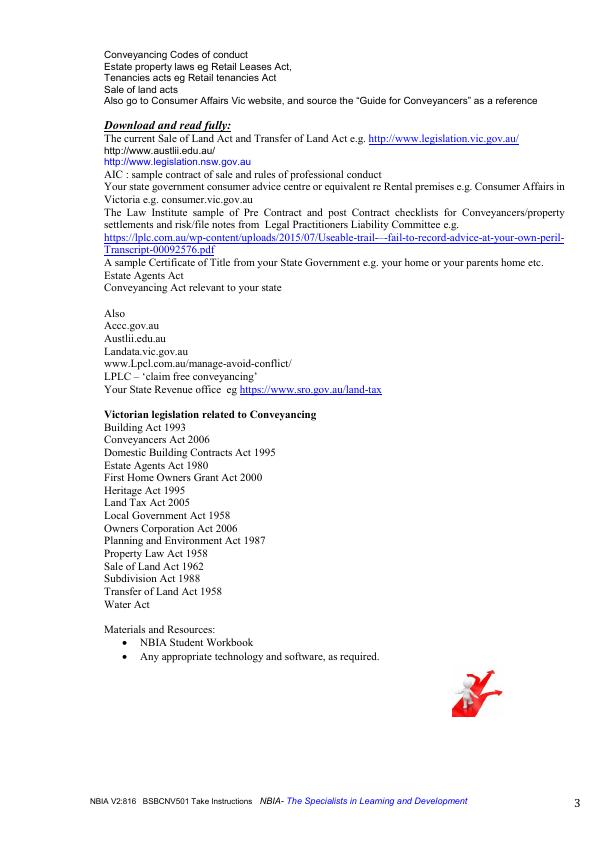
NBIA V2:816 BSBCNV501 Take Instructions NBIA- The Specialists in Learning and Development 4
The purpose of The Conveyancing Process is to provide skills in the field of land contract and business
law as might be relevant to a person working in a legal office, conveyancing department or office,
financial institution or bank loan or mortgage department, or other allied area. It will provide a
comprehensive knowledge of the documents and procedures encountered in conveyancing transactions
for the sale and purchase of Victorian land and businesses, and the effect of the relevant and associated
legislation.
The information covered in this module is very important because it provides you with an understanding
of the laws relating to the sale of land in Victoria and an overview of a conveyancing transaction from
initial instructions to settlement
The Oxford Dictionary’s definition of convey means to ‘transport, carry, communicate, transfer
property’. Real property is transmitted or made over to the new owner. A conveyance is the
documentary method of achieving the change of ownership. In the general law system, a deed of
conveyance is used. But in the Torrens system an instrument of transfer is the required method.
There are two types of property
o Real property – land and anything that is fixed to the land as part of the land.
o Personal property – goods or ‘chattels’ (of French origin) or things that are moveable
Real property is, of course, immovable and therefore cannot be physically given to the new owner. The
owner of the land is entitled to the land which carries the fixtures, as discussed previously. The law
requires all rights, title and interest in the land to be passed from one party to another. The proof of
ownership is not possession of the property on which most owners reside, but the legal interest in the title.
Conveyancers investigate title on behalf of vendors and purchasers and assist in the transmission of
estates and interest from one legal personality to another. This is called conveyancing.
A landowner does not have absolute right title and interest to the land. Ownership was granted by the
Crown and is subject to the Crown’s right to resume or compulsorily acquire the land for its purposes. As
original owner, the State Government resumes ownership of the land and the Federal Government
acquires the land for its purposes. In either situation, the owner is entitled to fair compensation.
However, the landowner has the best right to the land as against all other parties, except the Crown. Such
a right is known as a right in rem, a right against property. Freehold estates evolved from feudal systems
tenancies introduced to the United Kingdom by William the Conqueror in 1066 AD.
Modifications were made to this system with the introduction of a cash based economy where money was
substituted for the provision of physical services as payment for estates of interests in land
(which is what is actually purchased ie the right title and interest, the estate, in that land is transferred.)
A fee simple owner has the best right subject to the Crown. A mortgagee could have a right over the same
property to protect their interest. This means that the owner has rights which are good against the whole
world except someone with a better right.
The most valuable estate is a freehold estate and the owner’s rights would be better than all other
claimants. Ownership of land or part of land is defined by the rights and entitlements to the property.
A mortgagee has the right to sell the secured property if the mortgagor does not pay the mortgage debt,
and to recover the monies owing. A neighbour benefiting from an easement could have the right to cross
the land. A tenant would have the right to possession to the whole of the land during the term of the
agreement, while the owner still has the freehold. Therefore, various interests in land entitle the owner to
different rights. In addition, town planning, environment and other laws greatly affect the rights of
ownership of real property.
The purpose of The Conveyancing Process is to provide skills in the field of land contract and business
law as might be relevant to a person working in a legal office, conveyancing department or office,
financial institution or bank loan or mortgage department, or other allied area. It will provide a
comprehensive knowledge of the documents and procedures encountered in conveyancing transactions
for the sale and purchase of Victorian land and businesses, and the effect of the relevant and associated
legislation.
The information covered in this module is very important because it provides you with an understanding
of the laws relating to the sale of land in Victoria and an overview of a conveyancing transaction from
initial instructions to settlement
The Oxford Dictionary’s definition of convey means to ‘transport, carry, communicate, transfer
property’. Real property is transmitted or made over to the new owner. A conveyance is the
documentary method of achieving the change of ownership. In the general law system, a deed of
conveyance is used. But in the Torrens system an instrument of transfer is the required method.
There are two types of property
o Real property – land and anything that is fixed to the land as part of the land.
o Personal property – goods or ‘chattels’ (of French origin) or things that are moveable
Real property is, of course, immovable and therefore cannot be physically given to the new owner. The
owner of the land is entitled to the land which carries the fixtures, as discussed previously. The law
requires all rights, title and interest in the land to be passed from one party to another. The proof of
ownership is not possession of the property on which most owners reside, but the legal interest in the title.
Conveyancers investigate title on behalf of vendors and purchasers and assist in the transmission of
estates and interest from one legal personality to another. This is called conveyancing.
A landowner does not have absolute right title and interest to the land. Ownership was granted by the
Crown and is subject to the Crown’s right to resume or compulsorily acquire the land for its purposes. As
original owner, the State Government resumes ownership of the land and the Federal Government
acquires the land for its purposes. In either situation, the owner is entitled to fair compensation.
However, the landowner has the best right to the land as against all other parties, except the Crown. Such
a right is known as a right in rem, a right against property. Freehold estates evolved from feudal systems
tenancies introduced to the United Kingdom by William the Conqueror in 1066 AD.
Modifications were made to this system with the introduction of a cash based economy where money was
substituted for the provision of physical services as payment for estates of interests in land
(which is what is actually purchased ie the right title and interest, the estate, in that land is transferred.)
A fee simple owner has the best right subject to the Crown. A mortgagee could have a right over the same
property to protect their interest. This means that the owner has rights which are good against the whole
world except someone with a better right.
The most valuable estate is a freehold estate and the owner’s rights would be better than all other
claimants. Ownership of land or part of land is defined by the rights and entitlements to the property.
A mortgagee has the right to sell the secured property if the mortgagor does not pay the mortgage debt,
and to recover the monies owing. A neighbour benefiting from an easement could have the right to cross
the land. A tenant would have the right to possession to the whole of the land during the term of the
agreement, while the owner still has the freehold. Therefore, various interests in land entitle the owner to
different rights. In addition, town planning, environment and other laws greatly affect the rights of
ownership of real property.
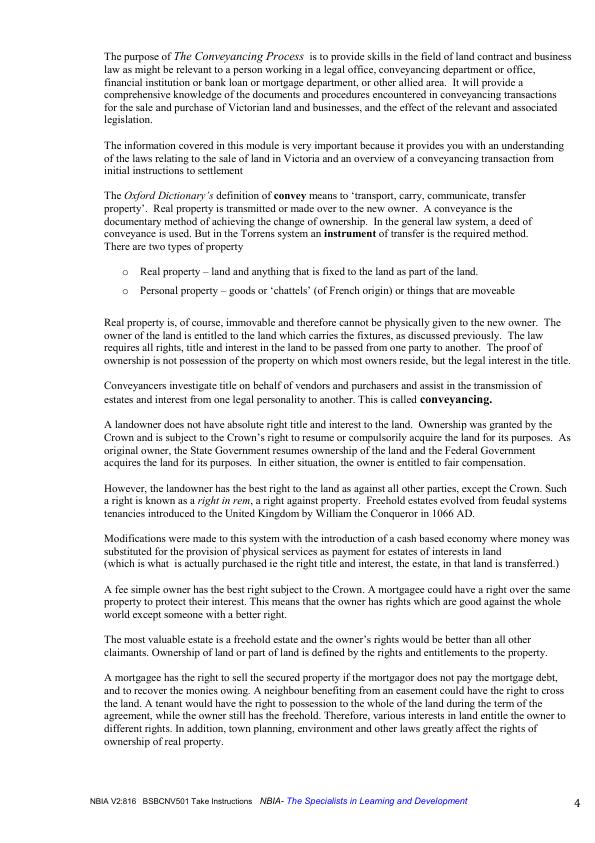
NBIA V2:816 BSBCNV501 Take Instructions NBIA- The Specialists in Learning and Development 5
A mortgage is a legal interest in land
Section 74(2) – gives interest in land to mortgagee
Mortgagee – lender; mortgagor – usually proprietor of land
Usually created to secure repayment of a loan or advance money
It is a statutory charge over the interest of the registered
When acting in a conveyancing transaction for vendor or purchaser, a practitioner must investigate
whether there is good title to the property. The common law principle which still governs the practice of
land contracts states that the vendor must show good safe holding marketable title. This is more easily
expressed as ‘good title’. The concept of good title is relevant also when considering the extent and
nature of the title in property law.
The conveyancer should always ask: Who is the proprietor of the land? and; What exactly is the
proprietor purporting to sell? i.e. the parameters of the interest in the land need to be determined to
assess whether the owner can give good title. Estates in land are classified as either freehold or less than
freehold e.g. a lease. A purchaser of land in Victoria today would require a freehold estate in fee
simple.
A lessee or tenant originally only had contractual rights and the interest classified as
personal property. Now, the interest in the land is recognised and a wronged tenant could recover
possession of the land, not merely damages. The freehold estate is said to be of uncertain duration, while
less than freehold estates are capable of certainty.
In Victoria, there are two methods of owning land with others – joint tenants and tenants-in-common.
Conveyancers need to seek instructions by discussing with clients the preferred method of co-ownership
by multiple purchasers of the same property. The way co-owners are registered may not be considered
significant by clients, but they need to be advised, depending on the situation, that their choice could
have serious consequences.
Indeed, the major difference between the types of co-ownership relates to the consequences for the
surviving party when one owner dies.
Use of the term ‘tenants’ in this context does not refer to tenants who rent property for occupation. Both
methods of co-ownership entitle the co-owners to equal possession of the land i.e. the land is not divided
into sections that one or other party may use.
It is important to note that the term joint tenants has the same
meaning as joint proprietors. The Land Registry uses
the terms joint proprietors and tenants on its title documents
when referring to co-owners’ interests
A mortgage is a legal interest in land
Section 74(2) – gives interest in land to mortgagee
Mortgagee – lender; mortgagor – usually proprietor of land
Usually created to secure repayment of a loan or advance money
It is a statutory charge over the interest of the registered
When acting in a conveyancing transaction for vendor or purchaser, a practitioner must investigate
whether there is good title to the property. The common law principle which still governs the practice of
land contracts states that the vendor must show good safe holding marketable title. This is more easily
expressed as ‘good title’. The concept of good title is relevant also when considering the extent and
nature of the title in property law.
The conveyancer should always ask: Who is the proprietor of the land? and; What exactly is the
proprietor purporting to sell? i.e. the parameters of the interest in the land need to be determined to
assess whether the owner can give good title. Estates in land are classified as either freehold or less than
freehold e.g. a lease. A purchaser of land in Victoria today would require a freehold estate in fee
simple.
A lessee or tenant originally only had contractual rights and the interest classified as
personal property. Now, the interest in the land is recognised and a wronged tenant could recover
possession of the land, not merely damages. The freehold estate is said to be of uncertain duration, while
less than freehold estates are capable of certainty.
In Victoria, there are two methods of owning land with others – joint tenants and tenants-in-common.
Conveyancers need to seek instructions by discussing with clients the preferred method of co-ownership
by multiple purchasers of the same property. The way co-owners are registered may not be considered
significant by clients, but they need to be advised, depending on the situation, that their choice could
have serious consequences.
Indeed, the major difference between the types of co-ownership relates to the consequences for the
surviving party when one owner dies.
Use of the term ‘tenants’ in this context does not refer to tenants who rent property for occupation. Both
methods of co-ownership entitle the co-owners to equal possession of the land i.e. the land is not divided
into sections that one or other party may use.
It is important to note that the term joint tenants has the same
meaning as joint proprietors. The Land Registry uses
the terms joint proprietors and tenants on its title documents
when referring to co-owners’ interests
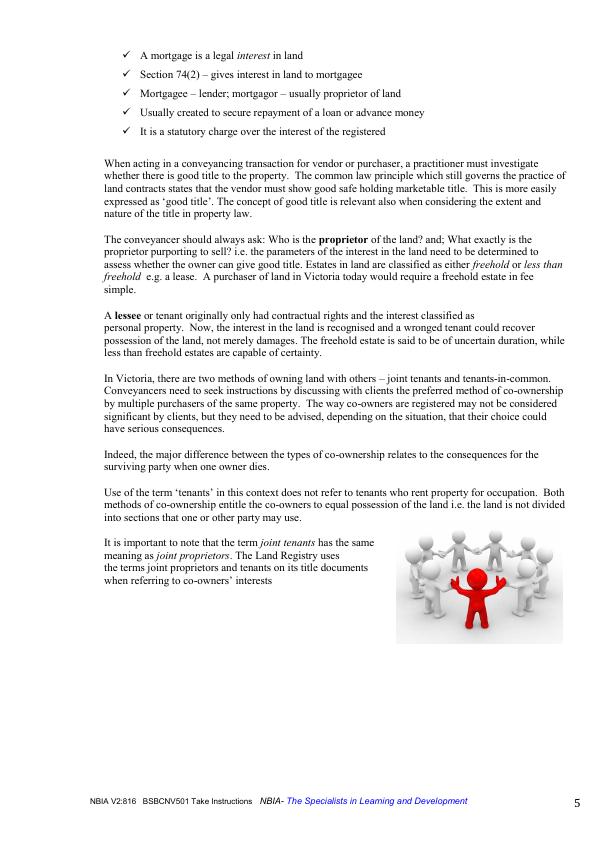
NBIA V2:816 BSBCNV501 Take Instructions NBIA- The Specialists in Learning and Development 6
ASIC and the training expectations
It has become almost impossible to discuss Financial Services and training without now mentioning
regulation. Australia is regarded as being at the cutting edge in terms of its financial services regulatory
framework, with a decade or more of structural changes to regulatory arrangements that are still rolling
through.
More recently, there have been a series of amendments to Corporations Law via the Financial Services
Reform Act (FSRA) that will see:
• Uniform regulation of all financial products;
• A single licensing regime for all financial products provided to retail consumers;
• Minimum standards of education/competence for those people advising retail consumers on
regulated financial products;
• Flexible arrangements for the authorisation of market operators and for clearing and settlement
facilities.
The licensing requirements are broadly based encompassing for example, the demonstration of
competence, ongoing professional development, probity checks .
The minimum educational expectations for financial product advisers identified in the FSRA require that
competence be measured against industry standards identified in the Financial Services Training
Package.
Only Registered Training Organisations may assess competence against the standards for compliance
purposes. The need for ongoing education and training to remain up-to-date is also recognised. These
resources relate specifically to one aspect of compliance - the demonstration of competence by advisers
The FSRA regulates and enforces various obligations of an Australian Financial Services Licence holder
including ensuring authorised representatives are adequately trained to provide financial product advice.
RG146 - Training of Financial Product Advisers provides guidance on the minimum training standards an
adviser must meet to comply with their obligations. Regulatory Guide 146 is prescriptive about ASIC's
expectations of organisations providing financial product advice to retail customers. In particular ASIC
expects that all licensees will undertake and meet:
• Job analysis
• Compliance analysis
• Training expectations
• Staff development strategy
What does this mean?
All representatives working in the specialist area of Financial Services, will need to be assessed by a
Registered Training Organisation against the knowledge and skill requirements set out by ASIC.
Please note that all representatives working under FSR Act are required to have a clear understanding
of the industry and its products, to ensure that appropriate strategies and solutions are recommended to
the client. This includes both generic knowledge and specialist product knowledge.
ASIC and the training expectations
It has become almost impossible to discuss Financial Services and training without now mentioning
regulation. Australia is regarded as being at the cutting edge in terms of its financial services regulatory
framework, with a decade or more of structural changes to regulatory arrangements that are still rolling
through.
More recently, there have been a series of amendments to Corporations Law via the Financial Services
Reform Act (FSRA) that will see:
• Uniform regulation of all financial products;
• A single licensing regime for all financial products provided to retail consumers;
• Minimum standards of education/competence for those people advising retail consumers on
regulated financial products;
• Flexible arrangements for the authorisation of market operators and for clearing and settlement
facilities.
The licensing requirements are broadly based encompassing for example, the demonstration of
competence, ongoing professional development, probity checks .
The minimum educational expectations for financial product advisers identified in the FSRA require that
competence be measured against industry standards identified in the Financial Services Training
Package.
Only Registered Training Organisations may assess competence against the standards for compliance
purposes. The need for ongoing education and training to remain up-to-date is also recognised. These
resources relate specifically to one aspect of compliance - the demonstration of competence by advisers
The FSRA regulates and enforces various obligations of an Australian Financial Services Licence holder
including ensuring authorised representatives are adequately trained to provide financial product advice.
RG146 - Training of Financial Product Advisers provides guidance on the minimum training standards an
adviser must meet to comply with their obligations. Regulatory Guide 146 is prescriptive about ASIC's
expectations of organisations providing financial product advice to retail customers. In particular ASIC
expects that all licensees will undertake and meet:
• Job analysis
• Compliance analysis
• Training expectations
• Staff development strategy
What does this mean?
All representatives working in the specialist area of Financial Services, will need to be assessed by a
Registered Training Organisation against the knowledge and skill requirements set out by ASIC.
Please note that all representatives working under FSR Act are required to have a clear understanding
of the industry and its products, to ensure that appropriate strategies and solutions are recommended to
the client. This includes both generic knowledge and specialist product knowledge.
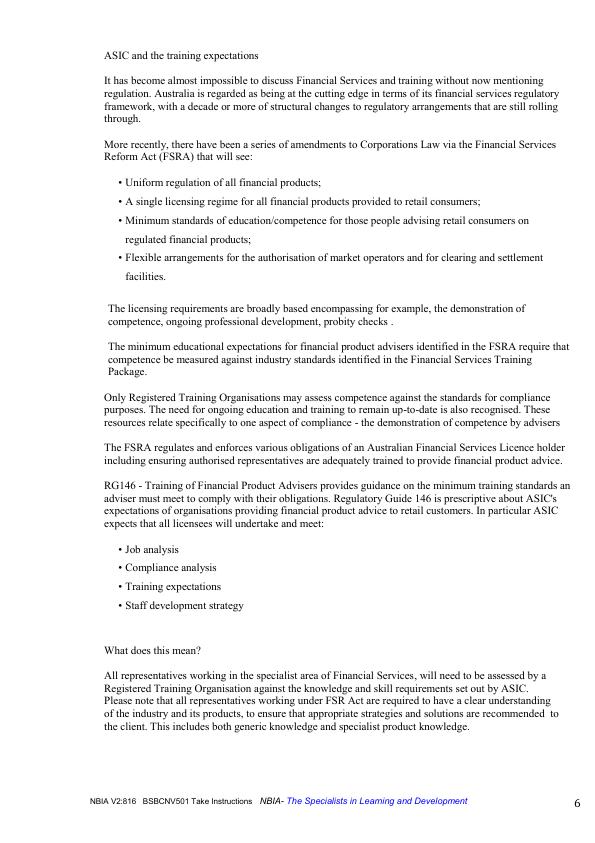
NBIA V2:816 BSBCNV501 Take Instructions NBIA- The Specialists in Learning and Development 7
The ASIC skills are a generic set of skills that apply across all of the industry areas. They describe a
typical, successful sales and/or advice encounter and it is expected that every adviser be able to
demonstrate these skills.
Competency standards provide a benchmark for competency based training and assessment and can be
applied in a number of ways across industry, enterprise and training contexts.
Competency based training is flexible in its process. It is about:
-knowing what people need to be able to do to carry out a job (competency)
-developing the competencies that meet workplace needs (training)
-ensuring that people can do what they are expected to do (assessment).
1 Establish client needs
Trust is an essential ingredient of the relationship between the adviser and the client. Developing rapport
and trust with a client takes time and skill.
First establish, are you acting for a Purchaser or a Vendor?
Addressing the concerns of the client is the first stage in the development of rapport or empathy. As you
gather information about the client, their financial circumstances and their financial goals and objectives,
the relationship between them should develop and strengthen.
The second element is using good listening techniques (often called active listening). This involves asking
questions, checking that they understand what the client is saying, and summarising to ensure that all
parties agree on the matters being discussed. It means focusing attention on the client (rather than on you)
in the discussion.
The next element is clear and appropriate explanation. There are many quite complex and conceptually
difficult matters to address with clients, such as types of products, taxation, and charges. Clients will
appreciate (and develop rapport with) explanations that are clear and easily understood.
Complex matters will be more easily understood if explanations are supported with visuals and
documentation. Using such supports will assist in creating rapport with the client.
It is essential in any form of advice that the client and the adviser
• Have not made any undue assumptions
• That all expectations are consistent and clear to both parties
• That all concerns are clarified and discussed by both parties
• That it is the clients needs and preferences that are met not the advisers.
Good Advice
ASIC RG175.26 Note 2 states that states that:
“Where an authorized representative is the providing entity, the authorizing licensee has an overriding
duty to ensure that the advice is provided in compliance with the law, including Pt 7.7. This is because
the authorizing licencee is obliged to take reasonable steps to ensure that its representatives comply with
the financial services laws....which include the FSG, suitability and SOA obligations....tThe licencee will
generally be subject to potential civil and criminal liability for any breach of the Pt 7.7 provisions by the
The ASIC skills are a generic set of skills that apply across all of the industry areas. They describe a
typical, successful sales and/or advice encounter and it is expected that every adviser be able to
demonstrate these skills.
Competency standards provide a benchmark for competency based training and assessment and can be
applied in a number of ways across industry, enterprise and training contexts.
Competency based training is flexible in its process. It is about:
-knowing what people need to be able to do to carry out a job (competency)
-developing the competencies that meet workplace needs (training)
-ensuring that people can do what they are expected to do (assessment).
1 Establish client needs
Trust is an essential ingredient of the relationship between the adviser and the client. Developing rapport
and trust with a client takes time and skill.
First establish, are you acting for a Purchaser or a Vendor?
Addressing the concerns of the client is the first stage in the development of rapport or empathy. As you
gather information about the client, their financial circumstances and their financial goals and objectives,
the relationship between them should develop and strengthen.
The second element is using good listening techniques (often called active listening). This involves asking
questions, checking that they understand what the client is saying, and summarising to ensure that all
parties agree on the matters being discussed. It means focusing attention on the client (rather than on you)
in the discussion.
The next element is clear and appropriate explanation. There are many quite complex and conceptually
difficult matters to address with clients, such as types of products, taxation, and charges. Clients will
appreciate (and develop rapport with) explanations that are clear and easily understood.
Complex matters will be more easily understood if explanations are supported with visuals and
documentation. Using such supports will assist in creating rapport with the client.
It is essential in any form of advice that the client and the adviser
• Have not made any undue assumptions
• That all expectations are consistent and clear to both parties
• That all concerns are clarified and discussed by both parties
• That it is the clients needs and preferences that are met not the advisers.
Good Advice
ASIC RG175.26 Note 2 states that states that:
“Where an authorized representative is the providing entity, the authorizing licensee has an overriding
duty to ensure that the advice is provided in compliance with the law, including Pt 7.7. This is because
the authorizing licencee is obliged to take reasonable steps to ensure that its representatives comply with
the financial services laws....which include the FSG, suitability and SOA obligations....tThe licencee will
generally be subject to potential civil and criminal liability for any breach of the Pt 7.7 provisions by the
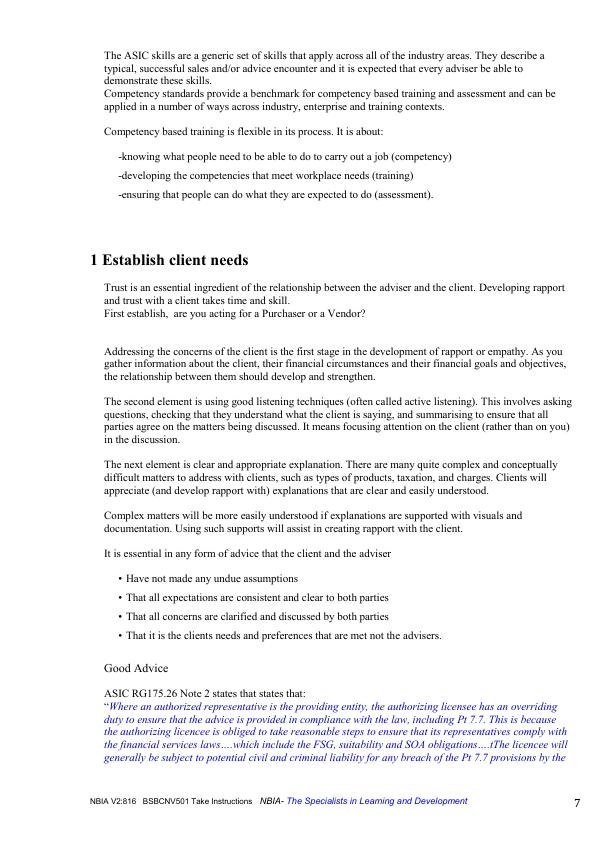
NBIA V2:816 BSBCNV501 Take Instructions NBIA- The Specialists in Learning and Development 8
authorized representatives. This is in addition to any action that may be taken directly against the
authorized representative.”
Therefore, if you do not act fairly, efficiently and honestly you are putting your licence at risk.
You must act in accordance with the Corporations Act, specifically Pt 7.7
ASIC policy statements and the FSRA 2001 and, without limiting these requirements, must have a
reasonable basis for all recommendations made to customers. In making a recommendation, you must:
Have regard to the customer's goals. financial situation and particular needs and personal
circumstances
Have the appropriate knowledge of, and approved accreditation in, the products being
recommended
Conduct reasonable investigations about the products recommended
Have a reasonable basis for all recommendations you make and advice you provide with regard to
the information gathered in (l) and (2)
In addition, you must always be able to demonstrate that you have acted with due care, diligently and
competently in making recommendations and preparing advice for customers.
After meeting your new client and going through introduction etc, discuss the contract – particularly if it
is already signed and go through it meticulously for any :
Special conditions
The settlement date
The type of land being transferred
The date the contrat was signed
The purchase, deposit, balance amounts.
Whether finance is being obtained
Make sure the Vendors Statement has been signed
Check the Vendors statement and all documents provided for accuracy and relevance.
1.2 Determine and discuss optional courses of action with client
Clients are entitled to full information about the products or policies proposed by providers of financial
services and this includes the impacts and possible risks of any solution proposed.
In implementing the FSRA, ASIC has developed "Good Disclosure Principles" which are aimed at
ensuring that the providers of financial products assist consumers to make confident and informed
decisions.
A key aspect of presenting information to clients, is that the information must be clear, concise and
understood by the client. If a client does not understand the information provided, they will be unable to
make a confident and reasoned decision about the product. It is the desired outcomes of the client that
determines your advice.
Advisers need to:
explain and discuss the solution(s) using clear and unambiguous language (ie. avoid the use of technical
or industry jargon; speak slowly and check for the client's understanding at frequent stages in the
authorized representatives. This is in addition to any action that may be taken directly against the
authorized representative.”
Therefore, if you do not act fairly, efficiently and honestly you are putting your licence at risk.
You must act in accordance with the Corporations Act, specifically Pt 7.7
ASIC policy statements and the FSRA 2001 and, without limiting these requirements, must have a
reasonable basis for all recommendations made to customers. In making a recommendation, you must:
Have regard to the customer's goals. financial situation and particular needs and personal
circumstances
Have the appropriate knowledge of, and approved accreditation in, the products being
recommended
Conduct reasonable investigations about the products recommended
Have a reasonable basis for all recommendations you make and advice you provide with regard to
the information gathered in (l) and (2)
In addition, you must always be able to demonstrate that you have acted with due care, diligently and
competently in making recommendations and preparing advice for customers.
After meeting your new client and going through introduction etc, discuss the contract – particularly if it
is already signed and go through it meticulously for any :
Special conditions
The settlement date
The type of land being transferred
The date the contrat was signed
The purchase, deposit, balance amounts.
Whether finance is being obtained
Make sure the Vendors Statement has been signed
Check the Vendors statement and all documents provided for accuracy and relevance.
1.2 Determine and discuss optional courses of action with client
Clients are entitled to full information about the products or policies proposed by providers of financial
services and this includes the impacts and possible risks of any solution proposed.
In implementing the FSRA, ASIC has developed "Good Disclosure Principles" which are aimed at
ensuring that the providers of financial products assist consumers to make confident and informed
decisions.
A key aspect of presenting information to clients, is that the information must be clear, concise and
understood by the client. If a client does not understand the information provided, they will be unable to
make a confident and reasoned decision about the product. It is the desired outcomes of the client that
determines your advice.
Advisers need to:
explain and discuss the solution(s) using clear and unambiguous language (ie. avoid the use of technical
or industry jargon; speak slowly and check for the client's understanding at frequent stages in the
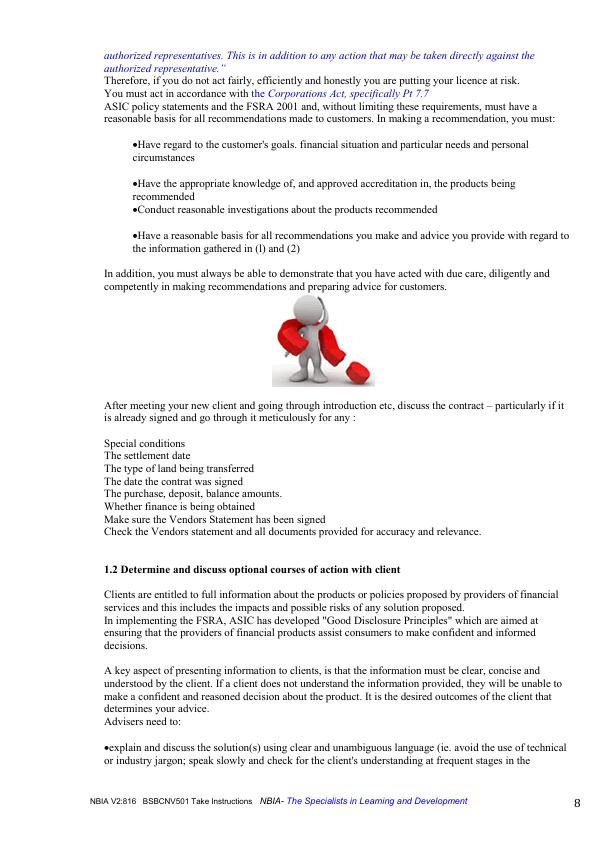
End of preview
Want to access all the pages? Upload your documents or become a member.
Related Documents
BSBCNV505 - Finalise the conveyancing transactionlg...
|62
|33587
|161
TAEDES401 & TAEDES402 Learner Workbook - Deskliblg...
|52
|14269
|215
Appeals Process, Recognised Prior Learning, Special Needslg...
|31
|7068
|245
SITXGLC001 - Research and Comply with Regulatory Requirements Assessment Workbooklg...
|41
|6018
|69
BSBMGT517 Manage Operational Plan Assignmentlg...
|26
|7315
|103
BSBLDR502 Lead and Manage Effective Workplace Relationshipslg...
|32
|6862
|81